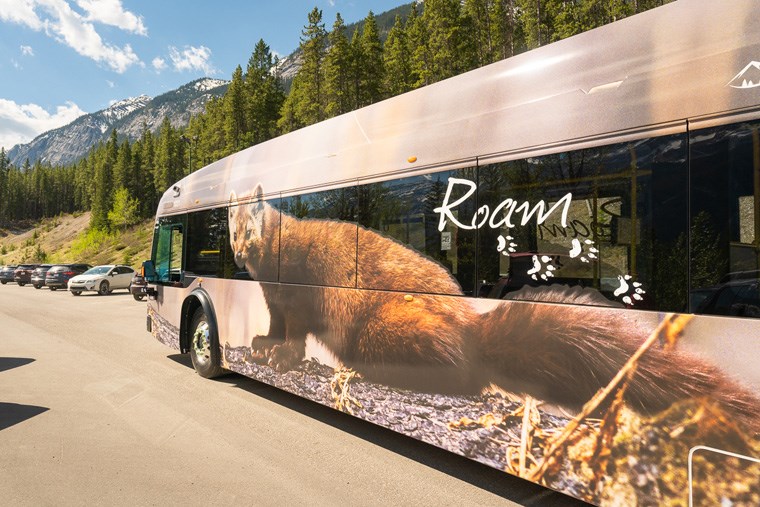BANFF – A push by Banff’s mayor to use paid parking revenues to fund initiatives to address the climate crisis has been parked for now, while the revenue stream can no longer be used as a potential option to stabilize tax increases.
Currently, the policy governing capital and operating spending from visitor paid parking revenues allows funds to cover transit initiatives, roadway and parking improvements, snow clearing enhancements, and cycling and other active transportation initiatives.
But Mayor Corrie DiManno wants some of the revenue to also cover climate resiliency programs, projects and initiatives, noting the municipality’s renewable energy transition roadmap recommendations come with hefty price tags.
“When we look to address climate resiliency it’s going to be expensive,” she said during the Oct. 23 council meeting, adding visitor paid parking revenues are a good fit given car-causing greenhouse gas emissions are contributing to climate change.
“Adding an outflow from visitor paid parking, which is a sustainable revenue stream for us, allows us to have another mechanism to fund these programs and projects that we know the community is very concerned about, and that the community would like us to continue to take really serious action on.”
The Town of Banff’s goals include an 80 per cent reduction in greenhouse gas emissions and a transition to 100 per cent renewable energy by 2050.
Its climate action plan, also known as the renewable energy transition roadmap, outlines the approach to achieve these targets, primarily by way of energy-efficient buildings, generating local low-carbon energy, importing renewable energy, and low-carbon transportation.
The cost of implementing the plan comes with a big price tag, with high-level financial modelling indicating an $327 million investment by the community over 30 years, to be offset by a projected net cost savings of more than $453 million over the same period.
Coun. Grant Canning, a council representative on the Bow Valley Regional Transit Services Commission (BVRTSC), wanted to hold off on adding climate resiliency as an option for visitor pay parking revenue spending.
“We all know our Roam transit numbers are jumping through the roof so it’s probably safe to say we’re going to be needing a lot more rolling stock over the next 10 years,” he said.
“For me, transit has always been the most important issue as it relates to funding from visitor paid parking and I think that is where most of the attention and the lion’s share of the funding should go.”
At this point, Canning said BVRTSC has approved doing a 10-year capital plan to determine needs moving forward.
“If I feel comfortable when that information comes back to council that we are sufficiently funding our capital needs for the next 10 years from a transit system perspective, and we have additional funds left over for other things, then I would be open to it,” he said.
With three councillors absent from the Oct. 23 meeting, and getting support from only Coun. Barb Pelham, a tied 2-2 vote with Couns. Canning and Hugh Pettigrew indicating opposition would have meant DiManno’s bid would fail.
While this conversation has been postponed until Nov. 13 so there can be a full council table, DiManno was successful in her bid to remove tax stabilization and economic recovery as a source for visitor pay parking funds.
She said this was added in 2021 during uncertain times associated with the COVID-19 pandemic in council’s bid to show extreme fiscal constraint.
“I think it was put there in a time – let’s just call it desperation. In reality, this has been an outflow that has been made in motions at budget time and it's never once passed,” she said.
“There’s just such a disconnect between tax stabilization and economic recovery when it comes to visitor paid parking and so, for me, I just don’t think it makes sense, and it’s not as transparent about where the money should be going in my opinion.”
Pettigrew, who was the councillor who initially pushed for visitor paid parking revenues to be used as a means to lower taxes, was the only councillor to fight against the mayor’s move.
He said residents and businesses are looking at a double digit tax increase for 2024 based on last year’s budget process and other proposed add-ons.
“I don’t know how we eliminate the option to put money away for a rainy day, especially when we raised the fees for paid parking from $3 to $5, which has created a windfall of additional funding,” he said.
“Eliminating the item for potential tax stabilization is wrong.”
The forecasted 2023 ending balance for the visitor paid parking operating reserve is $577,385. In 2024, the ending balance forecast is $1.7 million and $1.85 million in 2025.
As for the capital paid parking reserve, the predicted 2023 ending balance is $1.5 million, $1.56 million in 2024 and $814,300 in 2025. The big capital expenditures coming include construction of the Mountain Avenue dedicated express lane in 2024 and purchase of an electric bus in 2025.




